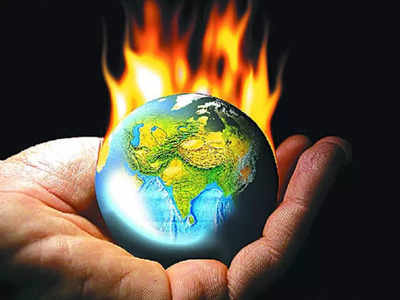- News
- Education News
- Learning with TOI News
- Explained: What causes global warming and climate change?
Trending
This story is from September 26, 2023
Explained: What causes global warming and climate change?
Uncover the science behind global warming and climate change, exploring the key drivers and their impact on our planet's future.

Global warming (representative image)
Global warming and climate change have become pressing issues in today's world. In this explainer, we'll break down the complex mechanisms behind these environmental challenges, shedding light on what causes global warming and its far-reaching consequences.
The Greenhouse Effect
To understand global warming, we must start with the greenhouse effect. Our planet naturally traps heat from the sun, maintaining temperatures suitable for life.However, the increase in greenhouse gases, such as carbon dioxide (CO2), methane (CH4), and nitrous oxide (N2O), has amplified this effect. These gases act like a blanket around Earth, preventing heat from escaping into space and raising temperatures.
Human Activities
The Domino Effect: Climate Change
Global warming doesn't just mean slightly warmer weather; it triggers a cascade of events collectively known as climate change. This includes:
Addressing the Challenge
Addressing global warming and climate change requires collective action. Governments, industries, and individuals must work together to:
Conclusion: A Call to Action
Understanding what causes global warming and climate change is the first step in addressing these critical issues. With concerted efforts to reduce emissions, protect ecosystems, and adapt to changing conditions, we can work toward a more sustainable and resilient future for our planet.
(This content is generated with the assistance of Artificial Intelligence)
The Greenhouse Effect
To understand global warming, we must start with the greenhouse effect. Our planet naturally traps heat from the sun, maintaining temperatures suitable for life.However, the increase in greenhouse gases, such as carbon dioxide (CO2), methane (CH4), and nitrous oxide (N2O), has amplified this effect. These gases act like a blanket around Earth, preventing heat from escaping into space and raising temperatures.
Human Activities
The primary driver of global warming is human activities. The burning of fossil fuels like coal, oil, and natural gas for energy and transportation is the largest contributor to greenhouse gas emissions. Deforestation, industrial processes, and agriculture also release significant amounts of these gases into the atmosphere. The result is an enhanced greenhouse effect, leading to rising temperatures.
The Domino Effect: Climate Change
Global warming doesn't just mean slightly warmer weather; it triggers a cascade of events collectively known as climate change. This includes:
- Melting Ice and Rising Sea Levels: The warmer temperatures cause polar ice caps and glaciers to melt, contributing to rising sea levels. This poses a threat to coastal communities worldwide.
- Extreme Weather Events: Global warming intensifies weather patterns, leading to more frequent and severe events such as hurricanes, droughts, and wildfires.
- Disruption of Ecosystems: Climate change disrupts natural habitats, affecting wildlife and plant species, and leading to biodiversity loss.
- Ocean Acidification: Increased CO2 levels not only warm the atmosphere but also get absorbed by the oceans, causing ocean acidification. This harms marine life, particularly coral reefs and shellfish.
- Altered Weather Patterns: Climate change can lead to shifts in rainfall patterns, impacting agriculture and freshwater availability.
Addressing the Challenge
Addressing global warming and climate change requires collective action. Governments, industries, and individuals must work together to:
- Reduce Greenhouse Gas Emissions: Transitioning to renewable energy sources, improving energy efficiency, and adopting sustainable land-use practices are crucial steps.
- Conservation and Reforestation: Protecting and restoring forests, which act as carbon sinks, is essential for mitigating the effects of climate change.
- Climate Adaptation: Preparing for and adapting to the changes that are already occurring, including building resilient infrastructure and communities.
- Global Cooperation: International agreements like the Paris Agreement aim to unite countries in the fight against climate change.
Conclusion: A Call to Action
Understanding what causes global warming and climate change is the first step in addressing these critical issues. With concerted efforts to reduce emissions, protect ecosystems, and adapt to changing conditions, we can work toward a more sustainable and resilient future for our planet.
(This content is generated with the assistance of Artificial Intelligence)
End of Article
FOLLOW US ON SOCIAL MEDIA










